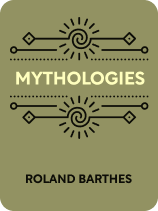

This article is an excerpt from the Shortform book guide to "Mythologies" by Roland Barthes. Shortform has the world's best summaries and analyses of books you should be reading.
Like this article? Sign up for a free trial here.
How pervasive is propaganda? How can you tell when a message is manipulative?
Propaganda is all around us. It might be a song, an image, an advertisement, or a headline. In Mythologies, Roland Barthes explains how myth is basically propaganda. He warns against its influence, so it’s important to know it when you see it.
Keep reading to learn how to recognize propaganda and keep from being deceived and used.
How to Recognize Propaganda
According to 20th-century French philosopher Roland Barthes, myths are being employed every day to influence our thoughts and perceptions of the world. Myth is essentially a means of culture creation. But, more specifically, he argues that it’s the creation of an “ideal culture” that obscures reality and diversity. And, particularly in the examples he analyzes from 1950s France, he says myth is created by the “bourgeois” (upper-middle class) for the “petit bourgeois” (lower-middle class) and “proletariat” (working class). So, although Barthes doesn’t use the word, he’s essentially arguing that myth is propaganda. Because of its pervasiveness and subtlety, it’s vital to learn how to recognize propaganda.
Propaganda is defined as “ideas, facts, or allegations spread deliberately to further one’s cause or to damage an opposing cause.” Myth as propaganda, as Barthes describes it, may be an even more insidious and ubiquitous fact of life today, with the use of the internet to spread (mis)information. Both social media and news outlets are used to spread political propaganda, swaying public opinion and creating greater political division. This reinforces social inequalities by pitting groups of people within the same socioeconomic classes against one another. When working and middle-class people are focused on blaming other working and middle-class people for their problems, they fail to unite to challenge the power structures dominated by the wealthy elite.
3 Tell-Tale Features of Propaganda
To avoid falling prey to this, it’s important to think critically about the information you encounter online and from media outlets and to learn to spot propagandist narratives when you encounter them. According to the Civil Liberties Union for Europe, you can recognize propaganda by some of these tell-tale features:
- It’s fear-based, creating an “us vs. them” narrative. Discourse that involves demonizing a group of people, such as immigrants, the LGBTQ+ community, a religious group, or an activist group, for example, might have propagandist motives. Be wary of any discourse that characterizes a whole category of people as “bad” or “the enemy.”
- It’s sensationalist. This may involve promoting an exaggerated narrative of a “threat” from some “outsider” group. For example, the idea that there’s a “war on Christmas” is sensationalized discourse in reaction to an attempt to be more inclusive with holiday greetings. The use of the term “war” implies violence and greatly exaggerates the threat.
- It appeals to popularity. This kind of narrative is called the “bandwagon technique,” because it’s an attempt to get people to jump on the “bandwagon,” meaning it promotes the idea that a cause, ideology, or candidate is so popular that you’ll be left out if you don’t support it. It convinces you that “everyone is doing it.” So, if you don’t get on board, you’re weird or different.
Exercise: Spot the Myths Around You
Barthes says that the most insidious thing about our cultural myths is their invisibility—the fact that we don’t notice them allows us to accept them without question. See if you can spot the myths you encounter today.
- As you scroll through the internet today, take note of any advertisements you come across. Stop and contemplate a few of them. Can you decipher any hidden messages in the images or phrasing used? Are any subtle messages being conveyed about race, gender, class, beauty, or politics? Describe one in as much detail as possible.
- Who do you think is benefitting from the myth you described, and how?
- Do you think this advertisement could eliminate the myth you perceived and still be effective in its job to sell the product or service? Why or why not?

———End of Preview———
Like what you just read? Read the rest of the world's best book summary and analysis of Roland Barthes's "Mythologies" at Shortform.
Here's what you'll find in our full Mythologies summary:
- The subtle messages that subconsciously shape the way we view the world
- How myths are used to reinforce cultural norms and values
- Why myths can pose dangers to society






